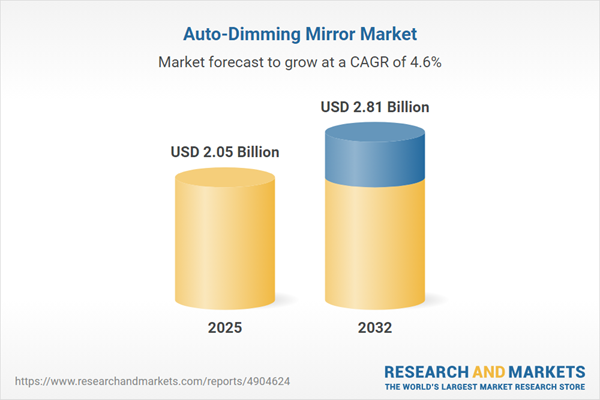Speak directly to the analyst to clarify any post sales queries you may have.
Auto-dimming mirrors are reshaping the automotive landscape, offering critical benefits for safety and passenger experience. As the sector evolves quickly alongside technology adoption and regulatory development, senior decision-makers must act on timely insights to maintain strategic agility and gain a measurable market advantage.
Market Snapshot: Auto-Dimming Mirror Market Size and Growth Outlook
The global auto-dimming mirror market is on a trajectory of stable expansion, driven by escalating safety standards and deeper integration of advanced vehicular technologies. In 2024, industry valuation reached USD 1.96 billion and is projected to climb to USD 2.05 billion by 2025, reflecting a compound annual growth rate (CAGR) of 4.61%. By 2032, expectations point to a market approaching USD 2.81 billion through dynamic shifts in OEM and aftermarket demand, greater compliance pressures, and continuing advances in product innovation. Regulatory adaptation, constant product upgrades, and agile strategy realignments among industry leaders shape the environment for sustained growth.
Scope & Segmentation: Strategic Insights for Auto-Dimming Mirror Market Leaders
Senior leadership aiming for competitive positioning requires granular insight into the auto-dimming mirror market’s segmentation and operational landscape. The following components represent the market’s diversity and areas for strategic action:
- Product Types: Electrochromic mirrors integrate sophisticated sensors to manage glare, while liquid crystal alternatives deliver adaptive performance for shifting automotive interiors and exteriors.
- Applications: Both interior and exterior auto-dimming mirrors advance global and regional vehicle safety objectives, contributing to improved driver visibility and comfort in compliance-driven contexts.
- Vehicle Types: Commercial vehicles, hatchbacks, sedans, and SUVs each benefit from tailored mirror solutions, providing ergonomic enhancements and compatibility with varying onboard technologies.
- Sales Channels: Distribution models span dealership networks and digital platforms, supporting seamless deployment across fleet and personally owned vehicles.
- Regional Focus: Market analysis covers the Americas, Europe, Middle East and Africa, and Asia-Pacific, with concentrated reviews of China, India, Japan, and South Korea. These regions present distinct compliance standards and production ecosystems, requiring nuanced supply chain and engagement strategies to optimize manufacturing and delivery capabilities.
- Featured Companies: The competitive field includes Gentex Corporation, Magna International Inc., Valeo SA, FICOSA International S.A., Motherson Sumi Systems Limited, Nippon Seiki Co., Tokai Rika Co., Ichikoh Industries, Denso Corporation, and Continental Aktiengesellschaft, collectively providing both global reach and localized expertise across the value chain.
Key Takeaways for Senior Leaders
- OEMs leverage state-of-the-art mirror technologies to elevate vehicle safety and connectivity perceptions, fostering distinct branding in a competitive market.
- Adoption of modular designs supports agile implementation of emerging driver assistance functionalities, enabling organizations to respond promptly to evolving regulatory and consumer trends.
- Strengthened collaboration between manufacturers and suppliers enhances the resilience of supply networks, ensuring consistent delivery amid variable sourcing conditions and reinforcing digital mobility efforts.
- Ongoing focus on driver comfort and visibility drives innovation for both OEM and aftermarket products, facilitating new partnership models and sector-wide advancement.
- Broad digital procurement strategies improve operational responsiveness and allow efficient use of resources, especially for OEMs and fleet managers with complex logistic requirements.
- Regional manufacturing initiatives not only meet compliance benchmarks but also underpin sustainability programs and support agile market adaptation.
Tariff Impact: Navigating Changing Supply Chains
With evolving U.S. tariff policies, auto-dimming mirror manufacturers have adapted sourcing and assembly decisions, particularly in relation to electrochromic components. By diversifying supplier networks and shifting production toward Asia and EMEA centers, organizations bolster supply assurance, comply with complex regional standards, and sustain business continuity as the demand landscape evolves.
Methodology & Data Sources
This analysis utilizes curated secondary industry data backed by firsthand intelligence from OEMs and component suppliers, further augmented by executive interviews. Synthesizing quantitative and qualitative insight supports senior teams with practical, strategic guidance calibrated for the sector’s realities.
Why This Report Matters: Strategic Intelligence for B2B Leaders
- Equips leadership with a robust reference for calibrating technology investments amid evolving compliance and regulatory requirements specific to the auto-dimming mirror market.
- Supports the creation of resilient sourcing strategies and operational networks capable of withstanding disruption and promoting adaptability.
- Enables a comprehensive evaluation of partnerships and supply ecosystems, unlocking opportunities for operational efficiency and sustained growth.
Conclusion
This report delivers actionable market intelligence, empowering executive decision-makers with the strategic context needed to cultivate adaptability and achieve leadership in the auto-dimming mirror sector.
Additional Product Information:
- Purchase of this report includes 1 year online access with quarterly updates.
- This report can be updated on request. Please contact our Customer Experience team using the Ask a Question widget on our website.
Table of Contents
3. Executive Summary
4. Market Overview
7. Cumulative Impact of Artificial Intelligence 2025
Companies Mentioned
The companies profiled in this Auto-Dimming Mirror market report include:- Gentex Corporation
- Magna International Inc.
- Valeo SA
- FICOSA International, S.A.
- Motherson Sumi Systems Limited
- Nippon Seiki Co., Ltd.
- Tokai Rika Co., Ltd.
- Ichikoh Industries, Ltd.
- Denso Corporation
- Continental Aktiengesellschaft
Table Information
| Report Attribute | Details |
|---|---|
| No. of Pages | 191 |
| Published | October 2025 |
| Forecast Period | 2025 - 2032 |
| Estimated Market Value ( USD | $ 2.05 Billion |
| Forecasted Market Value ( USD | $ 2.81 Billion |
| Compound Annual Growth Rate | 4.6% |
| Regions Covered | Global |
| No. of Companies Mentioned | 11 |









